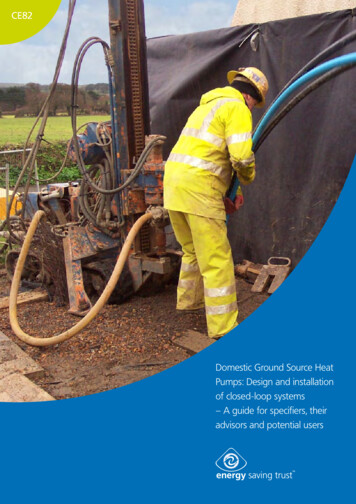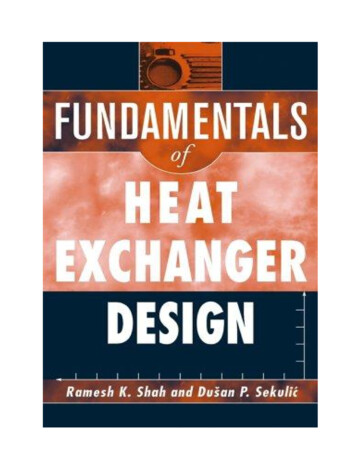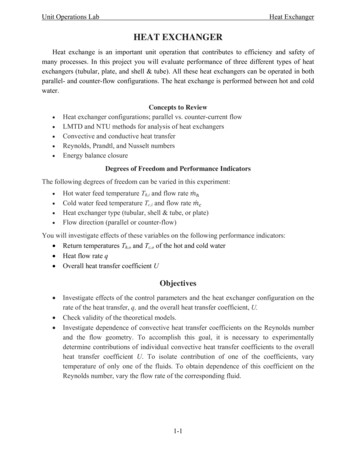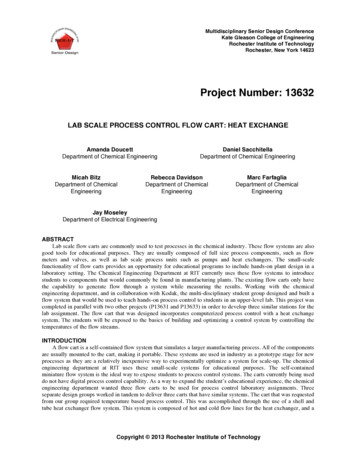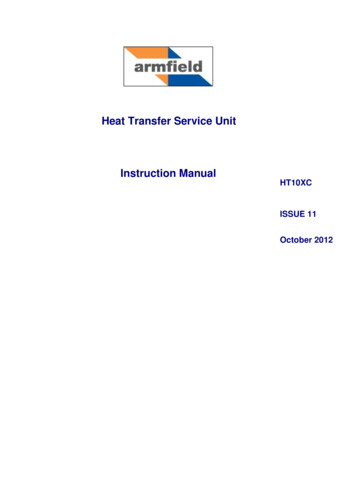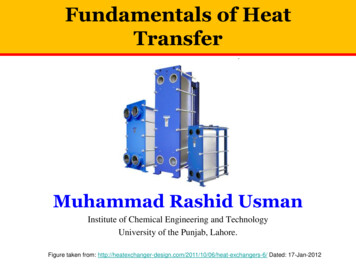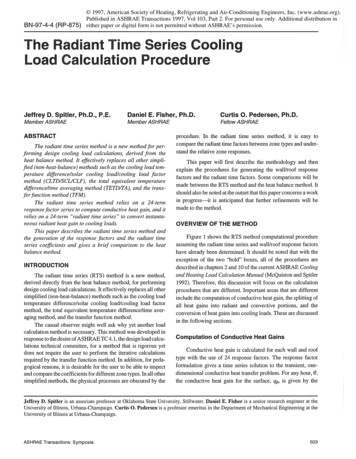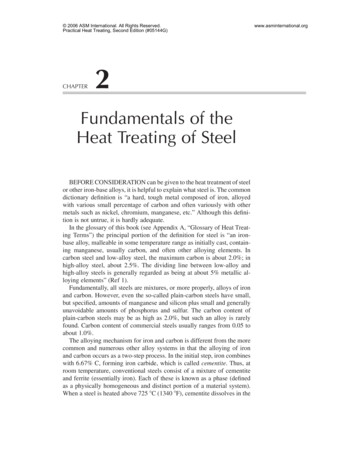
Transcription
2006 ASM International. All Rights Reserved.Practical Heat Treating, Second Edition (#05144G)CHAPTER2Fundamentals of theHeat Treating of SteelBEFORE CONSIDERATION can be given to the heat treatment of steelor other iron-base alloys, it is helpful to explain what steel is. The commondictionary definition is “a hard, tough metal composed of iron, alloyedwith various small percentage of carbon and often variously with othermetals such as nickel, chromium, manganese, etc.” Although this definition is not untrue, it is hardly adequate.In the glossary of this book (see Appendix A, “Glossary of Heat Treating Terms”) the principal portion of the definition for steel is “an ironbase alloy, malleable in some temperature range as initially cast, containing manganese, usually carbon, and often other alloying elements. Incarbon steel and low-alloy steel, the maximum carbon is about 2.0%; inhigh-alloy steel, about 2.5%. The dividing line between low-alloy andhigh-alloy steels is generally regarded as being at about 5% metallic alloying elements” (Ref 1).Fundamentally, all steels are mixtures, or more properly, alloys of ironand carbon. However, even the so-called plain-carbon steels have small,but specified, amounts of manganese and silicon plus small and generallyunavoidable amounts of phosphorus and sulfur. The carbon content ofplain-carbon steels may be as high as 2.0%, but such an alloy is rarelyfound. Carbon content of commercial steels usually ranges from 0.05 toabout 1.0%.The alloying mechanism for iron and carbon is different from the morecommon and numerous other alloy systems in that the alloying of ironand carbon occurs as a two-step process. In the initial step, iron combineswith 6.67% C, forming iron carbide, which is called cementite. Thus, atroom temperature, conventional steels consist of a mixture of cementiteand ferrite (essentially iron). Each of these is known as a phase (definedas a physically homogeneous and distinct portion of a material system).When a steel is heated above 725 C (1340 F), cementite dissolves in thewww.asminternational.org
2006 ASM International. All Rights Reserved.Practical Heat Treating, Second Edition (#05144G)www.asminternational.org10 / Practical Heat Treating: Second Editionmatrix, and a new phase is formed, which is called austenite. Note thatphases of steel should not be confused with structures. There are onlythree phases involved in any steel—ferrite, carbide (cementite), and austenite, whereas there are several structures or mixtures of structures.Classification of SteelsIt is impossible to determine the precise number of steel compositionsand other variations that presently exist, although the total number probably exceeds 1000; thus, any rigid classification is impossible. However,steels are arbitrarily divided into five groups, which has proved generallysatisfactory to the metalworking community.These five classes are: Carbon steelsAlloy steels (sometimes referred to as low-alloy steels)Stainless steelsTools steelsSpecial-purpose steelsThe first four of these groups are well defined by designation systemsdeveloped by the Society of Automotive Engineers (SAE) and the American Iron and Steel Institute (AISI). Each general class is subdivided intonumerous groups, with each grade indentified. The fifth group comprisesseveral hundred different compositions; most of them are proprietary.Many of these special steels are similar to specific steels in the first fourgroups but vary sufficiently to be marked as separate compositions. Forexample, the SAE-AISI designation system lists nearly 60 stainless steelsin four different general subdivisions. In addition to these steels (generallyreferred to as “standard grades”), there are well over 100 other compositions that are nonstandard. Each steel was developed for a specific application.It should also be noted that both standard and nonstandard steels aredesignated by the Unified Numbering System (UNS) developed by SAEand ASTM International. Details of this designation system can be foundin Ref 2. Coverage in this book, however, is limited to steels of the firstfour classes—carbon, alloy, stainless, and tool steels—that are listed bySAE-AISI.Why Steel Is So ImportantIt would be unjust to state that any one metal is more important thananother without defining parameters of consideration. For example, without aluminum and titanium alloys, current airplanes and space vechiclescould not have been developed.
2006 ASM International. All Rights Reserved.Practical Heat Treating, Second Edition (#05144G)www.asminternational.orgChapter 2: Fundamentals of the Heat Treating of Steel / 11Steel, however, is by far the most widely used alloy and for a very goodreason. Among layman, the reason for steel’s dominance is usually considered to be the abundance of iron ore (iron is the principal ingredient inall steels) and/or the ease by which it can be refined from ore. Neither ofthese is necessarily correct; iron is by no means the most abundant element, and it is not the easiest metal to produce from ore. Copper, forexample, exists as nearly pure metal in certain parts of the world.Steel is such an important material because of its tremendous flexibilityin metal working and heat treating to produce a wide variety of mechanical, physical, and chemical properties.Metallurgical PhenomenaThe broad possibilities provided by the use of steel are attributed mainlyto two all-important metallurgical phenomena: iron is an allotropic element; that is, it can exist in more than one crystalline form; and the carbonatom is only 1 30 the size of the iron atom. These phenomena are thus theunderlying principles that permit the achievements that are possiblethrough heat treatment.In entering the following discussion of constitution, however, it mustbe emphasized that a maximum of technical description is unavoidable.This portion of the subject is inherently technical. To avoid that wouldresult in the discussion becoming uninformative and generally useless.The purpose of this chapter is, therefore, to reduce the prominent technicalfeatures toward their broadest generalizations and to present those generalizations and underlying principles in a manner that should instruct thereader interested in the metallurgical principles of steel. This is done atthe risk of some oversimplification.Constitution of IronIt should first be made clear to the reader that any mention of moltenmetal is purely academic; this book deals exclusively with the heat treatingrange that is well below the melting temperature. The objective of thissection is to begin with a generalized discussion of the constitution ofcommercially pure iron, subsequently leading to discussion of the ironcarbon alloy system that is the basis for all steels and their heat treatment.All pure metals, as well as alloys, have individual constitutional orphase diagrams. As a rule, percentages of two principal elements areshown on the horizontal axis of a figure, while temperature variation isshown on the vertical axis. However, the constitutional diagram of a puremetal is a simple vertical line. The constitutional diagram for commercially pure iron is presented in Fig. 1. This specific diagram is a straight
2006 ASM International. All Rights Reserved.Practical Heat Treating, Second Edition (#05144G)www.asminternational.org12 / Practical Heat Treating: Second Editionline as far as any changes are concerned, although time is indicated onthe horizontal. As pure iron, in this case, cools, it changes from one phaseto another at constant temperature. No attempt is made, however, to quantify time, but merely to indicate as a matter of interest that as temperatureincreases, reaction time decreases, which is true in almost any solidsolution reaction.Pure iron solidifies from the liquid at 1538 C (2800 F) (top of Fig.1). A crystalline structure, known as ferrite, or delta iron, is formed (pointa, Fig. 1). This structure, in terms of atom arrangement, is known as abody-centered cubic lattice (bcc), shown in Fig. 2(a). This lattice has nineatoms—one at each corner and one in the center.As cooling proceeds further and point b (Fig. 1) is reached (1395 C,or 2540 F), the atoms rearrange into a 14-atom lattice a shown in Fig.2(b).The lattice now has an atom at each corner and one at the center ofeach face. This is known as a face-centered cubic lattice (fcc), and thisstructure is called gamma iron.Fig. 1Changes in pure iron as it cools from the molten state to room temperature. Source: Ref 3
2006 ASM International. All Rights Reserved.Practical Heat Treating, Second Edition (#05144G)www.asminternational.orgChapter 2: Fundamentals of the Heat Treating of Steel / 13As cooling further proceeds to 910 C (1675 F) (point c, Fig. 1), thestructure reverts to the nine-atom lattice or alpha iron. The change at pointd on Fig. 1 (770 C, or 1420 F) merely denotes a change from nonmagnetic to magnetic iron and does not represent a phase change. The entirefield below 910 C (1675 F) is composed of alpha ferrite, which continueson down to room temperature and below. The ferrite forming above thetemperature range of austenite is often referred to as delta ferrite; thatforming below A3 as alpha ferrite, though both are structurally similar.In this Greek-letter sequence, austenite is gamma iron, and the interchangeability of these terms should not confuse the fact that only twostructurally distinct forms of iron exist.Figures 1 and 2 thus illustrate the allotropy of iron. In the followingsections of this chapter, the mechanism of allotropy as the all-importantphenomenon relating to the heat treatment of iron-carbon alloys is discussed.Alloying MechanismsMetal alloys are usually formed by mixing together two or more metalsin their molten state. The two most common methods of alloying are byatom exchange and by the interstitial mechanism. The mechanism bywhich two metals alloy is greatly influenced by the relative atom size.The exchange mechanism simply involves trading of atoms from one lattice system to another. An example of alloying by exchange is the coppernickel system wherein atoms are exchanged back and forth.Fig. 2Arrangement of atoms in the two crystalline structures of pure iron.(a) Body-centered cubic lattice. (b) Face-centered cubic lattice
2006 ASM International. All Rights Reserved.Practical Heat Treating, Second Edition (#05144G)www.asminternational.org14 / Practical Heat Treating: Second EditionInterstitial alloying requires that there be a large variation in atom sizesbetween the elements involved. Because the small carbon atom is 1 30 thesize of the iron atom, interstitial alloying is easily facilitated. Under certainconditions, the tiny carbon atoms enter the lattice (the interstices) of theiron crystal (Fig. 2). A description of this basic mechanism follows.Effect of Carbon on the Constitution of IronAs an elemental metal, pure iron has only limited engineering usefulness despite its allotropy. Carbon is the main alloying addition that capitalizes on the allotropic phenomenon and lifts iron from mediocrity intothe position of a unique structural material, broadly known as steel. Evenin the highly alloyed stainless steels, it is the quite minor constituentcarbon that virtually controls the engineering properties. Furthermore, dueto the manufacturing processes, carbon in effective quantities persists inall irons and steels unless special methods are used to minimize it.Carbon is almost insoluble in iron, which is in the alpha or ferritic phase(910 C, or 1675 F). However, it is quite soluble in gamma iron. Carbonactually dissolves; that is, the individual atoms of carbon lose themselvesin the interstices among the iron atoms. Certain interstices within the fccstructure (austenite) are considerably more accommodating to carbon thanare those of ferrite, the other allotrope. This preference exists not only onthe mechanical basis of size of opening, however, for it is also a fundamental matter involving electron bonding and the balance of those attractive and repulsive forces that underlie the allotrope phenomenon.The effects of carbon on certain characteristics of pure iron are shownin Fig. 3 (Ref 3). Figure 3(a) is a simplified version of Fig. 1; that is, astraight line constitutional diagram of commercially pure iron. In Fig.3(b), the diagram is expanded horizontally to depict the initial effects ofcarbon on the principal thermal points of pure iron. Thus, each verticaldashed line, like the solid line in Fig. 3(a), is a constitutional diagram, butnow for iron containing that particular percentage of carbon. Note thatcarbon lowers the freezing point of iron and that it broadens the temperature range of austenite by raising the temperature A4 at which (delta)ferrite changes to austenite and by lowering the temperature A3 at whichthe austenite reverts to (alpha) ferrite. Hence, carbon is said to be anaustenitizing element. The spread of arrows at A3 covers a two-phaseregion, which signifies that austenite is retained fully down to the temperatures of the heavy arrow, and only in part down through the zone ofthe lesser arrows.In a practical approach, however, it should be emphasized that Fig. 1,as well as Fig. 3, represents changes that occur during very slow cooling,as would be possible during laboratory-controlled experiments, rather thanunder conditions in commercial practice. Furthermore, in slow heating ofiron, these transformations take place in a reverse manner. Transforma-
2006 ASM International. All Rights Reserved.Practical Heat Treating, Second Edition (#05144G)www.asminternational.orgChapter 2: Fundamentals of the Heat Treating of Steel / 15tions occurring at such slow rates of cooling and heating are known asequilibrium transformations, due to the fact that temperatures indicated inFig. 1.Therefore, the process by which iron changes from one atomic arrangement to another when heated through 910 C (1675 F) is called a transfo
Chapter 2: Fundamentals of the Heat Treating of Steel / 11 Steel, however, is by far the most widely used alloy and for averygood reason. Among layman, the reason for steel’s dominance is usually con-sidered to be the abundance of iron ore (iron is the principal ingredient in all steels) and/or the ease by which it can be refined from ore. Neither of these is necessarily correct; iron is by .

